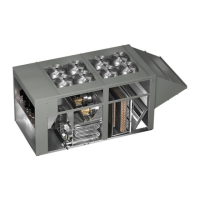
Do you have a question about the Greenheck RV and is the answer not in the manual?
Adherence to safety codes, electrical practices, and operational rules.
Ensuring proper grounding, fan RPM limits, and safe operation.
Procedures for checking incoming shipments for damage and completeness.
Guidelines for rigging, moving, and storing units to prevent damage.
Recommendations for periodic checks during storage.
Details available cooling, heating options, and airflow arrangements.
Specifies safety certifications and lists unit models and capacities.
Details blowers, coils, compressors, and dampers.
Covers optional features like electric heaters, furnaces, and DX/Split systems.
Explains filter types and the optional vestibule.
Provides dimensional data and weights for different unit sizes.
Specifies required clearances for access and additional needs for DX units.
Addresses safety and pre-lifting actions for units.
Instructions for safely lifting and rigging the unit using provided lugs.
Steps for installing roof curbs and setting the unit.
Guidance on optional vestibule attachment and ductwork configurations.
Guidelines for rail installation and preferred entry points for utilities.
Details on gas supply piping requirements and connections for furnaces.
Instructions for connecting optional water and DX coils.
Details on installing the P trap for condensate drainage and freeze protection.
Guidance on sizing power lines and wiring for optional electric heaters.
Covers power connection, convenience outlets, and low voltage wiring.
Recommendations for installing disconnect switches and fuses.
Identifies components on the high and low voltage sides of the main control center.
Details components and controls for the optional indirect gas-fired furnace.
Explains phase monitor function and VFD control for fan speed.
Outlines VFD modulation based on sensors or external signals for supply/exhaust fans.
Identifies components like TXV, coils, compressors, and pressure switches.
Describes optional hot gas bypass valve and reheat valve functions.
Crucial safety warnings and pre-energization requirements before start-up.
Overview of the start-up process and fields for recording essential unit data.
Comprehensive checklist of tasks to perform before initial unit operation.
Procedure for unit start-up, including fan rotation and voltage imbalance checks.
Lists essential tools required for performing the unit start-up.
Checklist items for recording line voltage, motor amps, and fan RPMs.
Monitoring compressor superheat, subcooling, pressures, and temperatures.
Checking moisture indicators and hot gas bypass functionality.
Ensuring correct fan rotation and adjusting supply fan offset.
VFD control for fans and identifying common causes of vibration.
Procedure for adjusting air seals and checking wheel rotation.
Inspecting drive belts and understanding operational sequences like economizer mode.
Semiannual inspection and cleaning procedures for the energy wheel.
Maintenance for belts, bearings, and steps for reassembling wheel segments.
Diagnosing issues with the energy wheel not turning or running intermittently.
Identifying and resolving alarm conditions from microprocessor and VFD.
Interpreting phase monitor LEDs for operational status and faults.
Diagnosing blower failure, motor starter chatter, and overload conditions.
Addressing low/high airflow, excessive noise, and vibration.
Diagnosing compressor start failures, cut-outs, and cycling problems.
Checking refrigerant levels, airflow, and line restrictions.
Resolving compressor cut-out due to high pressure or thermal overload.
Troubleshooting compressor hums, noise, vibration, and wiring issues.
Diagnosing causes of high suction and discharge pressures in the system.
Troubleshooting low suction pressure related to airflow or coil issues.
Addressing low discharge pressure, short cycling, and compressor oil loss.
Resolving insufficient cooling, liquid line frosting, and evaporator frost.
Scheduled maintenance for filters, motors, drains, and coils.
Annual checks, lubrication, and specific maintenance for DX units.
Procedures for component lubrication, damper checks, and filter maintenance.
Maintenance for fan motors, wheels, and cleaning of evaporator/condenser coils.
Provides spaces to log maintenance dates, times, and notes for tracking.
Details on product specifications, warranties, and support resources.
